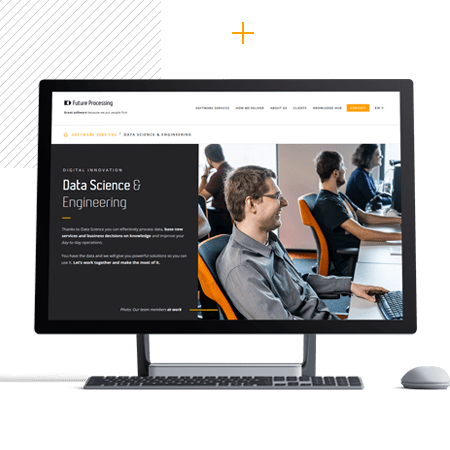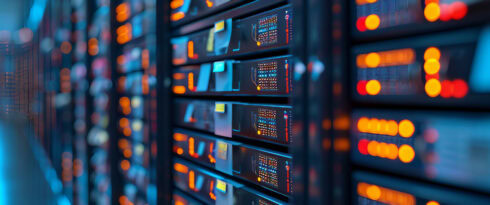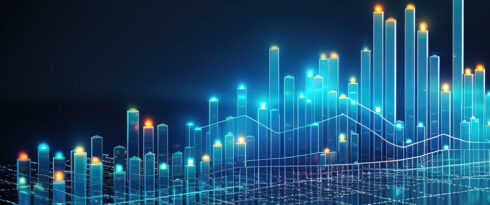
5 top data science trends that will change the face of business
Data is the most valuable asset of the 21st century, both literally and metaphorically speaking. That's a fact.
In case you haven’t noticed, there is a huge demand for big data analytics that influence business decisions, future investments, or entire marketing strategies. Both the world’s biggest players and small, emerging companies are willing to pay big bucks for real-time data collected by social media platforms or search engines.
What is data science?
Data governance, data processing, and data sharing are frequent search terms these days. Consequently, data scientists and data analysts are one of the most sought-after positions on popular job boards, like LinkedIn, Monster, or Indeed.
Data science offers unique advantages that can help any start-up grow and become competitive in its respective field. But it’s often overwhelming for entrepreneurs to decide which technology, tool, or area to focus on.
To help you make the right decision for your business, here are the five key trends that we believe will change the face of business in 2023.
1. Predictive Analytics
Investing in anything, from art to real estate, is a risky business. It requires a lot of nerve, knowledge, and skills. We would imagine the Wall Street traders, for instance, are very good at it. Nevertheless, it turns out that they also trust a… psychic before making important decisions involving big money. It might be a recent trend at the New York Stock Exchange. But we are certainly fans of more objective business tools to draw conclusions about the future. Predictive analytics is one of them.
The key word here, however, is finding patterns or predictive trends. It’s all about the ability to analyze past events or behaviors to find their common denominators that inform business decisions of the present about desired outcomes and actions in the future.
Credit risk assessment is an example of predictive analytics. Crime prevention is another. It also has applications in marketing. i.e. when choosing the right target group for a campaign ad.
Our highlight
Predictive analytics can also be applied in the health sector. Parkinson’s is one of the conditions that can be diagnosed, tracked, and monitored using this predictive trend methodology. Since it is a condition whose causes are unknown to modern medicine, we’re particularly interested in seeing how it will improve patients’ life expectancy.
2. Data Visualization Tools
When you’re looking for specific information or studying something new, do you remember it better when it’s written out in words and numbers or illustrated in some form? If it’s the latter, you’re amongst the 65% of the global population who are visual learners.
Social media has also significantly changed our perception of things in the 21st century. It’s very rare these days to see a post on any major platform without a visual element: a video, a photo, or an infographic. If you don’t include TikTok, Instagram Reels, or YouTube Shorts in your marketing strategy yet, you should probably familiarize yourself with these trendy applications with plenty of business potential.
In-depth reports are not the only type of database that has a bigger impact when presented visually. Sales and marketing materials, pitch decks, performance dashboards, and even client testimonials are “digested” much better by their intended recipients and business users if they are delivered that way. Another advantage of visualizing data is drastically reducing the amount of information presented. Here, the important aspects are data cleansing and data preparation. A written report that is a 1000-pages long can many times be translated into a few pages of infographics, saving time and energy that would otherwise go into analyzing endless lines of numbers and digits. Tableau, Google Charts, Datawrapper, or Sisense are just some of the more popular data visualization tools that can help you present big data analytics as graphs, diagrams, charts, or maps. And let’s not forget about the data spreadsheet that started it all – Excel.
Our highlight
In a society where videos are the most consumed form of content, we can imagine that data visualization tools will also be heading in the moving image direction. And we are here for it.
3. Natural Language Processing (NLP) and Text Mining
In 2019, a Batman saga fan created an artificial intelligence (AI) tool to write a script for a probable next part of the popular franchise. The bot watched 1,000 hours of the Gotham city-based movies and produced a plausible result, indeed.The story the artificial intelligence wrote starts with the following sentence, “This is now a safe city. I have punched a penguin into prison.” While it sounds amusing and not 100% authentic, it’s an example of a fairly successful implementation of natural language processing. Analyzing text has a lot of benefits beyond entertainment, too. It can help enhance customer service processes by introducing bots to answer the FAQs (frequently asked questions). It helps with foreign language translations (hello, Google Translate). And how do you think email spam is detected?
The first one uses the sentiment analysis approach, inferring the meaning from speech or text based on sentence structures, grammar, punctuation, etc. A popular tool used by copywriters, Grammarly, is a practical application of natural language processing. On the other hand, text mining will search for more statistically-oriented information. For instance, it will try to find word repetitions. That is why it is often deployed in SEO (search engine optimization) and other marketing tools that have something to do with positioning content.
Our highlight
Recruitment and human resources are currently facing new challenges since the pandemic accelerated the need to adapt to new working conditions and employee expectations. So, NLP and text mining are a great opportunities to better evaluate and match candidates with different roles within organizations.
4. Internet of Things (IoT) and Connected Devices
“Alexa, set the timer to nine minutes.”
“Siri, call Mum!”
“Hey Google, where’s the nearest gas station?”
“Hi Bixby, turn the lights off in the living room.”
No matter what smart devices and operating systems you use, you must have come across one of the voice-activated assistants before.
According to some estimates, there should be approximately 75.44 billion connected devices by 2025. In fact, your entire household can become one giant “connected device”: from a watch or a toaster to a fridge or even a car. Connected devices are the ones that can “talk” to each other over the Internet to perform certain actions. That communication, however, is rather simple: it means receiving and sending back information. This is what happens when you ask Alexa or Siri to turn the volume up when your favorite song is playing on the radio. Some of those devices are also smart, which means they can do basic computing tasks. If your AC (air conditioning) is smart, it will be able to control the temperature in the room based on the outdoor weather conditions without you having to tell it to do so.
Our highlight
Today, approximately 55% of the global population lives in cities. So mobility, livability, and resource management are increasingly becoming a major concern for local authorities. Therefore, we’re looking forward to seeing how fast the smart cities concept will progress in the near future.
5. Blockchain Technology and Cryptocurrency
What is the most expensive pizza you’ve ever ordered? It’s surely less than $298,175,464 that a computer programmer, Laszlo Hanyecz, paid for it in May 2010. Back then, cryptocurrency, in general, wasn’t widely accepted at all. So he used 10,000 Bitcoins to pay for the pizza as a challenge. 12 years ago, they were only worth about $41, compared to the nine-figure amount that it is today. Today, cryptocurrencies – essentially encrypted digital databases run by decentralized peer-to-peer networks – are legitimate forms of payment, even in some countries. Their worth proves their popularity as well. As of the beginning of June 2022, 1 Bitcoin was worth around $30k.
More and more banks adopt cryptocurrency trading in their operations. Blockchain solutions also allow all kinds of financial institutions to verify their clients’ identity, maintaining data privacy and ensuring no criminal actors or illicit transactions have access to their systems. Blockchain technology doesn’t show signs of slowing down at all. Its applications have gone well beyond financial services. In aviation, for instance, it could significantly improve tracking passenger bags, cargo shipments, or spare aircraft parts.
Our highlight
The creative sector has been greatly benefiting from this technology. In mid-May 2022, the NFT market, based on blockchain, generated accumulated 30-day sales of $77.5 million in the art segment itself, broadly speaking. So it’s high time to get seriously interested in those creative digital assets.
Conclusion
There’s no doubt that data science belongs to the top trends in the tech world today. As demonstrated above, it can certainly be an added value to your usual business processes. Historically speaking, most civilizations survived due to having developed a script and passing on stories and knowledge orally.
However, making that big data comprehensible and persuasive will require visualizing it. Moreover, AI solutions and ML algorithms are no longer just buzzwords. Their analytics capabilities make them vital additions to business intelligence tools in industries ranging from education to supply chain management. They provide an incomparably faster analysis of large data sets than any team composed of data scientists could ever attempt. Last but not least, human beings constantly look for ways to make their lives simpler and more convenient. The IoT and connected devices have made that possible on a grand scale. So when it comes to the latest trends, we’re putting our money on data science. It will not only continue changing the world in 2023 but definitely beyond.

Do you want to create your own, strong Big Data strategy?
See how we can work it out in Future Processing’s team.



